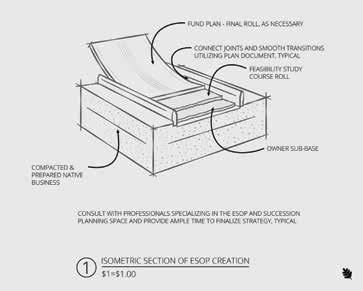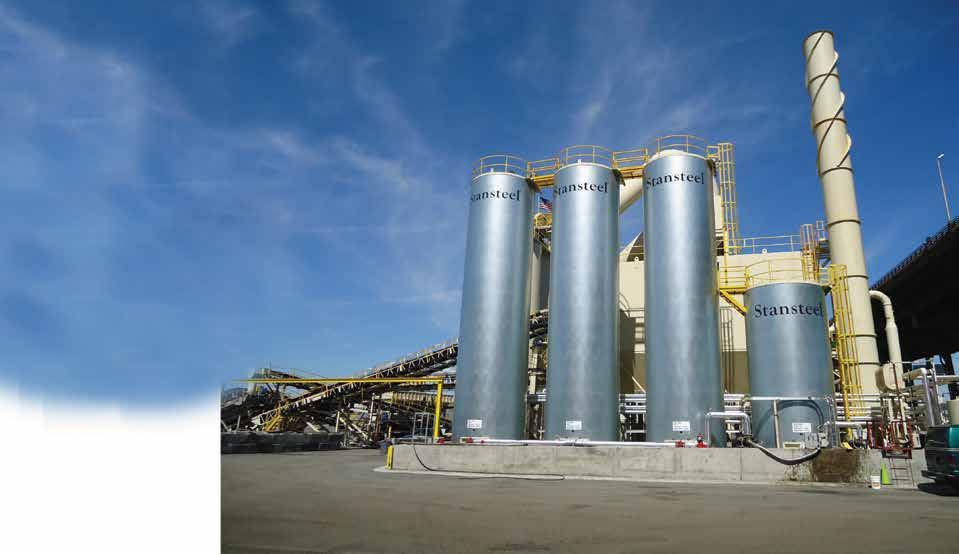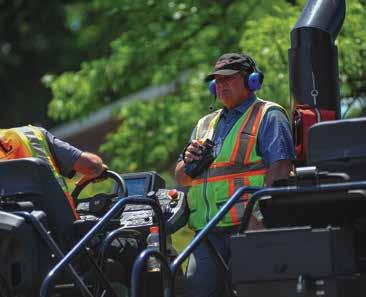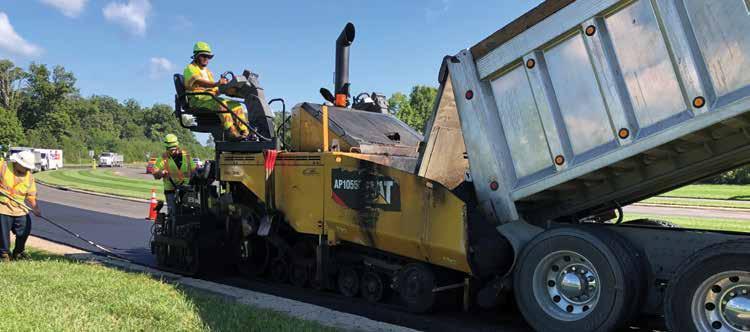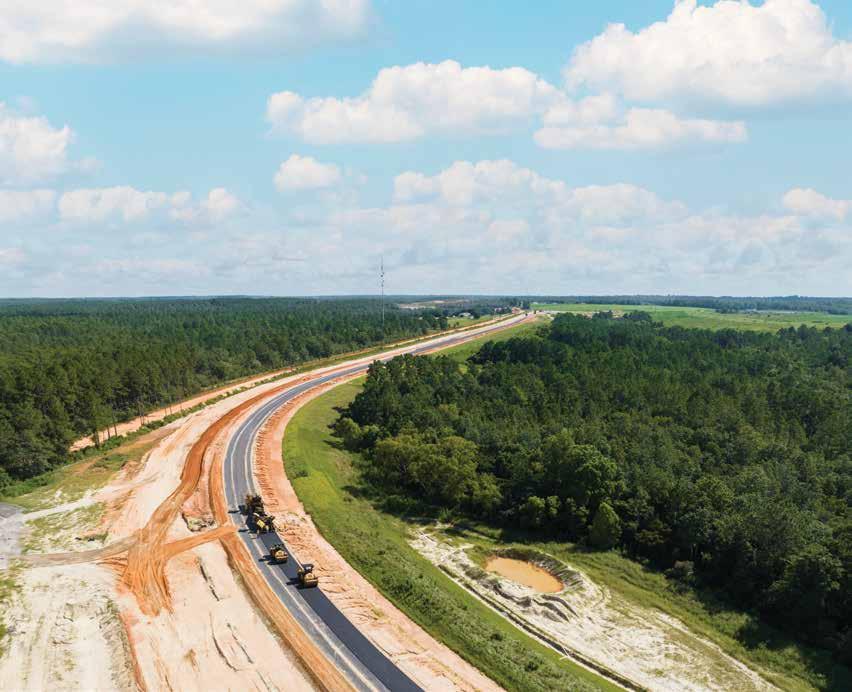
12 minute read
Caltrans Investigates Work Zone Intrusion Alarms
BY SARAH REDOHL
Between 2016 and 2020, work zone fatalities increased from 782 to 857, according to the American Road and Transportation Builders Association (ARTBA) National Work Zone Safety Information Clearinghouse. One safety trend that aims to reduce work zone fatalities is the implementation of Work Zone Intrusion Alarm (WZIA) systems.
WZIAs alert workers and drivers of potential intrusions into the work zones through the use of alarms or alerts connected to radar-, camera-, infrared-based or other hardware and software.
The California Department of Transportation (Caltrans) has partnered with a research team led by Associate Professor Ghazan Khan of California State University Sacramento's Department of Civil Engineering to investigate some of the WZIA options.
“With the availability of new systems and safety solutions on the market, there was a need to review and analyze WZIAs to see how we can supplement the best practices already in use to further improve safety,” Khan said.
What sets the research conducted by Khan’s team apart from existing research is the emphasis placed on the workers’ perspective. “How are crews going to perceive these systems, what issues will they identify and how will they utilize these devices—that was our goal,” Khan said.
His team identified five different WZIA systems to test in close-to-traffic conditions and trained Caltrans maintenance crews on their use prior to deployment in an active work zone. The five systems selected by Khan’s team were the Traffic Guard Worker Alert System, SonoBlaster, Intellicone Incursion Prevention and Warning, Intellicone Single Sentry Beam and AWARE Sentry. Let’s take a closer look at each system.
1. Traffic Guard Worker Alert System
The Traffic Guard Worker Alert System (WAS) includes a 12-foot lightweight, portable trip hose and sensor assembly that when driven over sends a wireless signal to an alarm and flashing light. Multiple hoses can be connected wirelessly to offer a larger area of coverage, Khan said. However, the team found that for long work zones, it may be difficult to maintain alarm ranges and hoses may have to be redeployed as the work zone moves forward.
His team recommended hoses be placed within 225 feet of an alarm device, compared to the manufacturer’s range of 1,000 feet. The team also recommended using three or four alarm units to enhance the warning sound in the work area, as the volume of a single alarm (60 to 70 dBA for five or six seconds) may not be sufficient.
They also discovered that the alarm units don’t perform well if placed on the ground, but that the magnet on each unit makes it easy to attach them to any metallic structure or vehicle at a height of 4 feet or higher.
The AWARE Sentry was one of five work zone intrusion alarms Ghazan Khan and his team tested in active Caltrans work zones.
Khan and his team did not measure time-delays for each device, but Khan noted that “the time involved when a device is activated and when the alarm goes off was almost imperceptible, hence we decided it was sufficient for the needs and in the context of work zone application.”
“One unique feature of WAS is the personal safety device (PSD) workers can carry in pocket or on their body to provide audible and vibration warnings that an incursion has occurred and they should take evasive action,” Khan said.
Khan's team tested the WAS device in an active work zone on westbound U.S. Highway 50 (65 mph speed limit). The project entailed a closure of the four-lane freeway’s shoulder so crews could repair some fencing. The crew deployed three sensor hoses parallel to the movement of traffic right where the closure was at the start of the work zone. “We had recommended they place them diagonally in the closure, but the workers actually deployed it this way because they thought it would be more effective given the nature and speed of traffic at that location,” Khan said.
Setup of the four alarm units at various locations (two on one truck, one each on two other trucks) took only five minutes. The crew reported that deployment, operation and retrieval were easy. “A lot of them also liked the flexibility of the device and the ability to place it wherever they’d like,” Khan said.
During the operation of WAS, there were five false alarms, four of which were the result of one worker accidentally pressing a button on his PSD and one from a worker accidentally stepping on the hose.
2. SonoBlaster
According to Khan, SonoBlaster is essentially a pressure horn activated by a CO2 cartridge that can be mounted on traffic cones, drums, delineators, a-frames and other barricades. “When the cartridge is punctured, such as

In Stock Now

when a vehicle hits a cone that SonoBlaster is installed on, it releases a pressurized gas, which blows the horn to warn workers,” he said. The audio alarm sounds at 125 dBA, by far the loudest of the devices Khan’s team tested, for anywhere between 15 and 90 seconds depending on how the cartridge is punctured.
“There’s no need for batteries or charging, but the coverage is limited to cones on which SonoBlasters are installed,” Khan said, adding that installation takes some time. Once the Caltrans maintenance crew Khan’s team taught to install the devices had gotten familiar with the process, each device installation averaged 10 to 12 minutes. When Khan’s team conducted trials with the device, 16 were successful and four failed as a result of improper seating of the CO2 cartridge. Furthermore, it’s also possible to trigger the alarm when deploying or clearing cones. “There’s a switch that has to be turned on to arm the unit and once turned on, if the cone tilts, this can trigger the alarm unit.”
The researchers also discovered that cones equipped with SonoBlasters could not be transported in two rows at the back of a cone body truck, though the cones can still stack on top of one another for deployment from the front of a truck.
SonoBlaster was deployed on a live work zone along eastbound U.S. Highway 50. It was intended to be deployed in the ramp closure area of the project, but when the project supervisor decided the ramp didn’t need to close down on the day of testing, the crew deployed SonoBlasters along the lane closure portion of the project but stopped after only arming three units.
“Very quickly the workers decided it was not a good idea because of exposure to traffic,” Khan said. Ultimately, Khan’s team found that SonoBlasters may only be suitable for specific types of work zones, such as ramp closures.
3. Intellicone Incursion Prevention and Warning
The Intellicone Incursion Prevention and Warning (Intellicone) system consists of a Portable Site Alarm (PSA) and lamps installed on the tops of traffic cones. “When a cone is hit and the cone lamp is dislodged, it triggers the alarm, which can warn the workers,” Khan said. This results in a visual alarm (rotating lights on the cone lamp) as well as a three-tone audio alarm of 70 to 90 dBA for 30 seconds. “We found that to be sufficiently loud, especially if you utilize multiple alarm units,” Khan said.
The cone lamps connect wirelessly with each other and the alarm units at a range of up to 100 feet, “so you can provide as much coverage as you would like as long as you ensure the maximum distance between two units is not more than 100 feet,” Khan said. He also noted the ability for two alarm units to connect to each other via the cellular network at an unlimited range, “but obviously that depends on the availability of cell phone coverage.”
The Intellicone system also offers broader work zone management features such as an online management dashboard and mobile alerts.
Ten Intellicone lamps were deployed in a work zone on westbound U.S. Highway 50. “Some workers shared concerns about exposure while deploying the cone lamps,” Khan said, adding that the team is discussing best practices for safe deployment. However, they considered deployment and utilization of the system easy, and the PSA setup and connection took about two minutes.
4. Intellicone Single Sentry Beam The Intellicone Single Sentry Beam portable laser (Intellicone Laser) is a device that shoots a laser beam at various distances (set by the user) between 35 and 110 feet. Any disruption of the laser beam triggers the same PSA unit used in the Intellicone Incursion Prevention and Warning system.
Although the Intellicone Laser provides more continuous coverage than the other Intellicone system, Khan said, the range of 35 to 110 feet is limiting, especially if laser deployment is desired parallel to the moving traffic, and considering that multiple lasers cannot be connected to extend coverage. However, the limited range makes sense; “That’s to prevent any accidental activations if you want to deploy it on a single lane or limited space,” Khan said.
The Intellicone Laser has a battery life of 120 hours.
The research team observed that the laser should be within 175 feet of the PSA, which is less than the manufacturer’s range of 250 feet. Khan said a single laser/alarm pair might not be sufficient for high speed or longer work zones and that multiple pairs might be required to provide adequate coverage and warning.
Despite the crew’s concerns that the system might not provide ample warning, they did find the system easy to deploy, operate and retrieve. During the live work zone test on eastbound Highway 50, the crew placed the laser perpendicular to oncoming traffic after initial setup/range configuration and the PSA on a truck in the work area.
5. AWARE Sentry
The AWARE (Advanced Warning and Risk Evasion) Sentry is a radar-based system with a 15-hour battery life that monitors nearby traffic speed within a range of 600 feet to predict potential incursions. “If it assumes a high probability of an incursion, it triggers an alarm that warns workers and drivers,” he said. The alarm includes an audio alarm that sounds somewhat like a police siren and a visual alarm of flashing white and amber lights.
If a vehicle is traveling slightly above the speed threshold (set manually by the operator), AWARE will alert the driver to slow down. If a vehicle is traveling significantly faster than the speed threshold, AWARE will alert both the driver and workers. “This cuts down on any false alarms which might make the workers immune to these alerts,” Khan said. “Not only does [the system] warn workers and drivers, but it’s also the only system that doesn’t have to wait for an incursion to occur.”
LEARN MORE
These devices are sold at a variety of traffic control suppliers. Contact your local or regional safety device distributor and ask for the system by name. Let them know you saw the product detailed in AsphaltPro Magazine. This article will appear on theasphaltpro.com under the Safety Spotlight department for easy reference.
BUILT TO CONNECT
Efficiency and Productivity
Designed with safety and operator comfort in mind, the SB-3000 Shuttle Buggy® material transfer vehicle features adaptive cruise control, bright LED lighting, four-wheel steering for easy transport and ground-level maintenance access for added convenience. Operators can rely on clear sightlines and the ground operator is safely protected inside the structure of the machine. The Roadtec SB-3000 is the perfect blend of traditional craftsmanship and modern technology.

AWARE Sentry also comes with a personal safety device workers can carry to provide an audio and vibration alarm if an intrusion occurs. Furthermore, the system can record a short video anytime the alarm is triggered for later review.
The speed threshold is set by the user via a mobile app. Khan said the crews would have preferred the option of configuring the Sentry directly from the device. Setting the right speed threshold is particularly important to the system’s effectiveness to minimize false alerts.
When AWARE Sentry was deployed in an active work zone, a flagging operation on the two-lane Highway 16 (55 mph speed limit), the initial speed threshold of 35 mph was too low. “We were having a lot of triggers because so many cars were traveling faster than that,” Khan said. “Anytime this system is deployed, it’s critical to make sure the system is set up properly for the traffic flow and speed.” Prior speed information would be useful in appropriately setting the thresholds.
THE BOTTOM LINE
According to a survey Khan’s team conducted after the crew training but before the active work zone deployment, the crew rated the WAS, Intellicone and Intellicone Laser as the most effective in mitigating work zone crashes. However, the crews generally reported that they thought all devices would increase work zone safety. “This was reflected in discussions with them also, that any device or system that can provide a warning to workers or drivers would be beneficial given the safety issues they face every day in these work zones,” Khan said.
Ultimately, Khan’s team uncovered several key takeaways. For example, the importance of designating a supervisor or lead worker to take responsibility to make sure the system is deployed and used correctly.
Another key takeaway was that certain systems are best suited for certain locations. For example, they found the AWARE Sentry is ideal for flagging operations and slow moving traffic. “Detailed information about the active work zones where the systems are to be deployed is critical to ensure the right devices are utilized at the right location,” Khan said.
Khan’s team tested these five WZIA systems in active work zones with high-speed traffic, but in the future plans to test them in work zones with lower traffic speeds to evaluate their performance in various types of traffic and work zone conditions. Khan said some concerns with deployment and exposure in the initial active work zone tests might not be an issue at sites with relatively lower speed limits, “as such the results may vary in the future with further tests.”
Next, Khan and his team plan to perform additional testing in active work zones, conduct further surveys with Caltrans crews who have used the systems, coordinate with manufacturers on the team’s recommendations, and investigate new devices such as Guardian Cone.
ON THE ROAD TO NET ZERO EMISSIONS,

WE CAN HELP YOU FIND YOUR WAY.
Are you exploring NAPA’s climate challenge, but unsure of your navigation? We can help you take at least one step forward — by replacing your tank heaters, hot oil heaters, fuel oil preheaters, and distributor truck heaters with our zero-emission, 100% efficient, Lo-Density® drywell-style electric heat. Check out our new operating cost calculator at processheating.com!
PROCESS HEATING COMPANY


